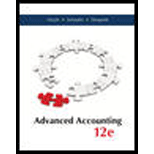
a.
Prepare Company P’s entries to account for the consideration transferred to the former owners of Company S, the direct combination costs, and the stock issue and registration costs.
a.
Explanation of Solution
| General Journal | ||||
| Date | Account Title and Explanation | Post Ref. | Debit | Credit |
| i) | Receivables and inventory | $ 180,000 | ||
| Cash | $ 85,000 | |||
| Property, plant and equipment | $ 600,000 | |||
| Research and development asset | $ 100,000 | |||
| Trademarks | $ 200,000 | |||
| $ 77,500 | ||||
| Liabilities | $ 180,000 | |||
| Common stock | $ 250,000 | |||
| Additional paid-in capital | $ 750,000 | |||
| $ 62,500 | ||||
| (to record the assets and liabilities acquired) | ||||
| ii) | Professional service | $ 15,000 | ||
| Cash | $ 15,000 | |||
| (being Stock issuance cost paid) | ||||
| iii) | Additional paid-in capital | $ 9,000 | ||
| Cash | $ 9,000 | |||
| (being Stock issuance cost paid) | ||||
Table: (1)
Computation of the fair value of the consideration transferred:
Thus, the fair value of the consideration transferred in this combination is $1,000,000.
b.
Prepare a post-acquisition column of accounts for company P.
b.
Explanation of Solution
The post-combination
| Particulars | Company P | Company S | Consolidated Entries | Consolidated Balances | ||
| Revenues | ($1,200,000) | ($1,200,000) | ||||
| Expenses | $890,000 | $890,000 | ||||
| Net income | ($310,000) | ($310,000) | ||||
| ($950,000) | ($950,000) | |||||
| Net income | ($310,000) | ($310,000) | ||||
| Dividends declared | $90,000 | $90,000 | ||||
| Retained earnings,12/31 | ($1,170,000) | ($1,170,000) | ||||
| Cash | $86,000 | $85,000 | $0 | $171,000 | ||
| Receivables and inventory | $750,000 | $190,000 | $10,000 | $930,000 | ||
| Property, plant, and equipment | $1,400,000 | $450,000 | $150,000 | $2,000,000 | ||
| Investment in Company S | $1,062,500 | $705,000 | ||||
| $357,500 | ||||||
| Research and development asset | $100,000 | $100,000 | ||||
| Goodwill | $77,500 | $77,500 | ||||
| Trademarks | $300,000 | $160,000 | $40,000 | $500,000 | ||
| Total assets | $3,598,500 | $885,000 | $3,778,500 | |||
| Liabilities | ($500,000) | ($180,000) | ($680,000) | |||
| Contingent liability | ($62,500) | ($62,500) | ||||
| Common stock | ($650,000) | ($200,000) | $200,000 | ($650,000) | ||
| Additional paid-in capital | ($1,216,000) | ($70,000) | $70,000 | ($1,216,000) | ||
| Retained earnings | ($1,170,000) | ($435,000) | $435,000 | ($1,170,000) | ||
| Total liabilities and equities | ($3,598,500) | ($885,000) | $1,072,500 | $1,072,500 | $3,778,500 | |
Table: (2)
c.
Prepare a worksheet to produce a consolidated balance sheet as of the acquisition date.
c.
Explanation of Solution
The worksheet to consolidate the two companies as of the combination date is as follows:
| Particulars | Company P | Company S | Consolidated Entries | Consolidated Balances | ||
| Revenues | ($1,200,000) | ($1,200,000) | ||||
| Expenses | $890,000 | $890,000 | ||||
| Net income | ($310,000) | ($310,000) | ||||
| Retained earnings, 1/1 | ($950,000) | ($950,000) | ||||
| Net income | ($310,000) | ($310,000) | ||||
| Dividends declared | $90,000 | $90,000 | ||||
| Retained earnings,12/31 | ($1,170,000) | ($1,170,000) | ||||
| Cash | $86,000 | $85,000 | $0 | $171,000 | ||
| Receivables and inventory | $750,000 | $190,000 | $10,000 | $930,000 | ||
| Property, plant, and equipment | $1,400,000 | $450,000 | $150,000 | $2,000,000 | ||
| Investment in Company S | $1,062,500 | $705,000 | ||||
| $357,500 | ||||||
| Research and development asset | $100,000 | $100,000 | ||||
| Goodwill | $77,500 | $77,500 | ||||
| Trademarks | $300,000 | $160,000 | $40,000 | $500,000 | ||
| Total assets | $3,598,500 | $885,000 | $3,778,500 | |||
| Liabilities | ($500,000) | ($180,000) | ($680,000) | |||
| Contingent liability | ($62,500) | ($62,500) | ||||
| Common stock | ($650,000) | ($200,000) | $200,000 | ($650,000) | ||
| Additional paid-in capital | ($1,216,000) | ($70,000) | $70,000 | ($1,216,000) | ||
| Retained earnings | ($1,170,000) | ($435,000) | $435,000 | ($1,170,000) | ||
| Total liabilities and equities | ($3,598,500) | ($885,000) | $1,072,500 | $1,072,500 | $3,778,500 | |
Table: (3)
Want to see more full solutions like this?
Chapter 2 Solutions
Loose Leaf Advanced Accounting with Connect Access Card
- On March 1, 20X1, your company,which uses Units-of-Production (UOP) Depreciation, purchases a machine for $300,000.arrow_forwardPlease provide the accurate answer to this general accounting problem using valid techniques.arrow_forwardI am searching for the right answer to this financial accounting question using proper techniques.arrow_forward
- Please explain the solution to this general accounting problem with accurate principles.arrow_forwardI am searching for the correct answer to this general accounting problem with proper accounting rules.arrow_forwardi will give unhelpful.blurr image please comment i will write values. please dont Solve with incorrect values otherwise unhelpful.arrow_forward

 AccountingAccountingISBN:9781337272094Author:WARREN, Carl S., Reeve, James M., Duchac, Jonathan E.Publisher:Cengage Learning,
AccountingAccountingISBN:9781337272094Author:WARREN, Carl S., Reeve, James M., Duchac, Jonathan E.Publisher:Cengage Learning, Accounting Information SystemsAccountingISBN:9781337619202Author:Hall, James A.Publisher:Cengage Learning,
Accounting Information SystemsAccountingISBN:9781337619202Author:Hall, James A.Publisher:Cengage Learning, Horngren's Cost Accounting: A Managerial Emphasis...AccountingISBN:9780134475585Author:Srikant M. Datar, Madhav V. RajanPublisher:PEARSON
Horngren's Cost Accounting: A Managerial Emphasis...AccountingISBN:9780134475585Author:Srikant M. Datar, Madhav V. RajanPublisher:PEARSON Intermediate AccountingAccountingISBN:9781259722660Author:J. David Spiceland, Mark W. Nelson, Wayne M ThomasPublisher:McGraw-Hill Education
Intermediate AccountingAccountingISBN:9781259722660Author:J. David Spiceland, Mark W. Nelson, Wayne M ThomasPublisher:McGraw-Hill Education Financial and Managerial AccountingAccountingISBN:9781259726705Author:John J Wild, Ken W. Shaw, Barbara Chiappetta Fundamental Accounting PrinciplesPublisher:McGraw-Hill Education
Financial and Managerial AccountingAccountingISBN:9781259726705Author:John J Wild, Ken W. Shaw, Barbara Chiappetta Fundamental Accounting PrinciplesPublisher:McGraw-Hill Education





